The avoidance of a government shut-down means we will get Nonfarm Payrolls on Friday, after all

Outlook: The avoidance of a government shut-down means we will get nonfarm payrolls on Friday, after all. Reuters reports the consensus forecast is for a rise by 163,000, down from 187,000 in August and with the unemployment rate ticking down to 3.7%.
Before then, we get rate decisions and messaging from the RBA and RBNZ.
Today it’s the US ISM manufacturing PMI (47.6 in Aug for the ninth month under 50 in a row and not likely much better this time). Mssrs Powell and Harker (Philadelphia) speak today. Tomorrow it’s JOLTS, then ISM non-manufacturing on Wednesday, and weekly jobless claims on Thursday.
Last Thursday and Friday, with wildly gyrating yields, equity prices and exchange rates, was lesson in the value of Surprises, mostly inflation falling more than forecast and a bond sell-off in the US that took the yield down 12 points in just a few hours.
We need to keep in mind that yields traders are not reflecting the “real” economy, which we still measure by GDP. There the US is in fine fettle while recession looms for the UK and Europe. The dollar response—a giant drop followed by a sharp recovery—was exaggerated by its oversold condition.
Or maybe not. Yields are not the only factor. Even given the drop in yields, the US still offers the best collection of sentiment-contributors—the highest or nearly the highest yields in the developed economy world, high and resilient growth, a stubborn central bank, and that last bastion of risk aversion, a safe haven.
On Friday we thought the “all bonds all the time” fever was breaking. But PCE came in pretty much as expected, including the core at 3.9%, validating the Fed’s hawkishness. Inflation is doing really well under the circumstances even if the public doesn’t see it that way and the Fed is demanding more.
Some experts think the Fed will win, so to speak, taking the 10-year yield to 5% or more. That’s the view of BlackRock CEO Fink and Pershing Square Capital’s Ackman, two often cited managers. They see “structural” inflation that is only more endangered by the price of oil and whatever effect higher interest rates have on some sectors.
Oh, boo-hoo. Interest rates at 5% and over are not catastrophically high given recent history. Those of us who worked in the Volcker years remember Fed funds at 20% on some days. You’d think everyone responding to conditions and writing about them all entered the market after 2008, only 15 years ago, A Reader reminded us that “in 2007 the Treasury curve was practically flat from 1 year to 30 years at 5.50%.... The problem is that people got so used to 0% post 2008 they thought it was normal. … [But] Zero is not normal.” A flat yield curve is not normal, either. Yield curves slope upward for the simple and obvious reason that risk rises the farther out in time you go. What risk? Mostly inflation but also the rest of the pantry—sovereign, credit, institutional, geopolitical, etc.
The real question is whether interest rates are now slowing down the US and eurozone economies, or higher rates are just a thorn in the side of businesses and consumers. If the higher rates really are slowing down economics, we should see fewer job openings, downward pressure on wages or at least wage increases, and finally, declining inflation.
Those betting in the Fed funds market seem to think the slowdown is upon us and with special hurdles—another government shut-down, the expanding autoworkers strike, those student loan repayments, a looming commercial real property crash, etc. Various consumer delinquencies are on the rise, as are small company bankruptcies. Those seeing that last rate hike at the Nov meeting have contracted to a mere 25.7% from 33.5% a month ago. See the CME FedWatch tool.
Forecast: The dollar is on its yield-driven upswing again but in some real danger of losing its grip, despite better metrics all around now but the possibility of recession sometime soon on the rise, according to Bloomberg economists. We saw its vulnerability last week. A lot depends on attitudes towards the US, including those from within the house.
Fun Tidbit: Two American fraudsters go on trial today, Trump and FTX founder Bankman-Fried.
This is an excerpt from “The Rockefeller Morning Briefing,” which is far larger (about 10 pages). The Briefing has been published every day for over 25 years and represents experienced analysis and insight. The report offers deep background and is not intended to guide FX trading. Rockefeller produces other reports (in spot and futures) for trading purposes.
To get a two-week trial of the full reports plus traders advice for only $3.95. Click here!
This is an excerpt from “The Rockefeller Morning Briefing,” which is far larger (about 10 pages). The Briefing has been published every day for over 25 years and represents experienced analysis and insight. The report offers deep background and is not intended to guide FX trading. Rockefeller produces other reports (in spot and futures) for trading purposes.
To get a two-week trial of the full reports plus traders advice for only $3.95. Click here!
Author

Barbara Rockefeller
Rockefeller Treasury Services, Inc.
Experience Before founding Rockefeller Treasury, Barbara worked at Citibank and other banks as a risk manager, new product developer (Cititrend), FX trader, advisor and loan officer. Miss Rockefeller is engaged to perform FX-relat

















